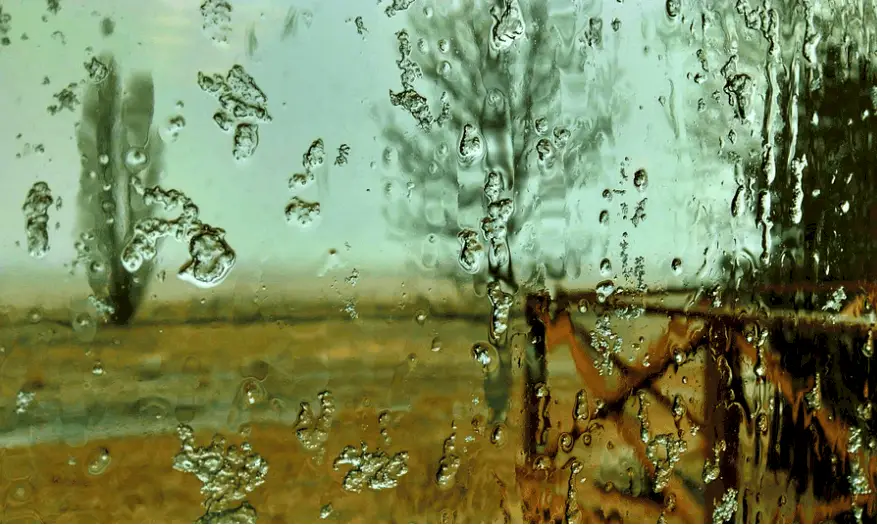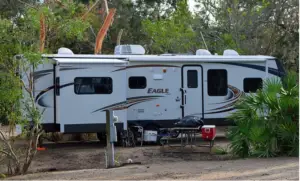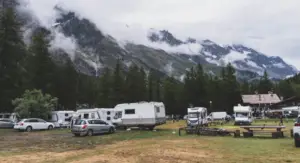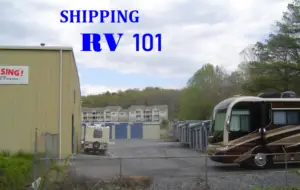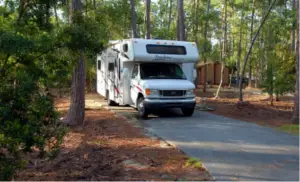Condensation inside a camper or travel trailer is a common problem with a lot of RVers. It can result in other issues like molds and thus, one should be proactive in preventing it.
What is condensation and why it is bad for RV?
Condensation is nothing but droplet of water that sticks on cold surfaces when humid air comes in contact with it. This water, if left unattended can result in issues like mold, musty smells, rusting of metal surfaces and rotted wood surfaces.
It can result in long term damage to your RV which may need costly repairs.
Condensation is mostly visible on windows or walls but it can also happen at hidden areas like closet or other unnoticeable areas. That’s why, it is important to tackle the problem else it may go unnoticed.
How to stop condensation in RV
So, how do you stop or reduce condensation in a camper?
The best way to stop condensation in RV is by using a dehumidifier, big enough to keep the RV dry by removing moisture from air. Insulating the RV or using other methods to keep surfaces warm in conjugation with low humidity level can also prevent condensation in RV.
Humidity is nothing but the amount of water vapor in air. Relative humidity is used to measure the humidity. Hygrometer can be used to calculate it.
Can be confusing! For now, just know below point. We will see in details.
Water vapor or moisture in warm air inside the RV causes the condensation when it meets the cold surfaces like windows, walls, floor, cabinets or ceiling .
Before I get into different tips let me tell you broadly on how you can tackle the condensation problems.
There are mainly two things that you need to do to stop the condensation in RV.
- Remove the water vapor from air.
- Make sure surfaces like windows, walls, ceiling, floor or other hidden surfaces do not become very cold.
Condensation starts when the moisture from dry air meets cool surfaces like window glasses or other metal surfaces. So, your focus should be on doing either of these 2 things.
The best way out is always removing the moisture. Insulating the RV or air circulation can make the differences but there will still be hidden areas that will still cause the condensation.
Below are the different ways to prevent condensation inside an RV.
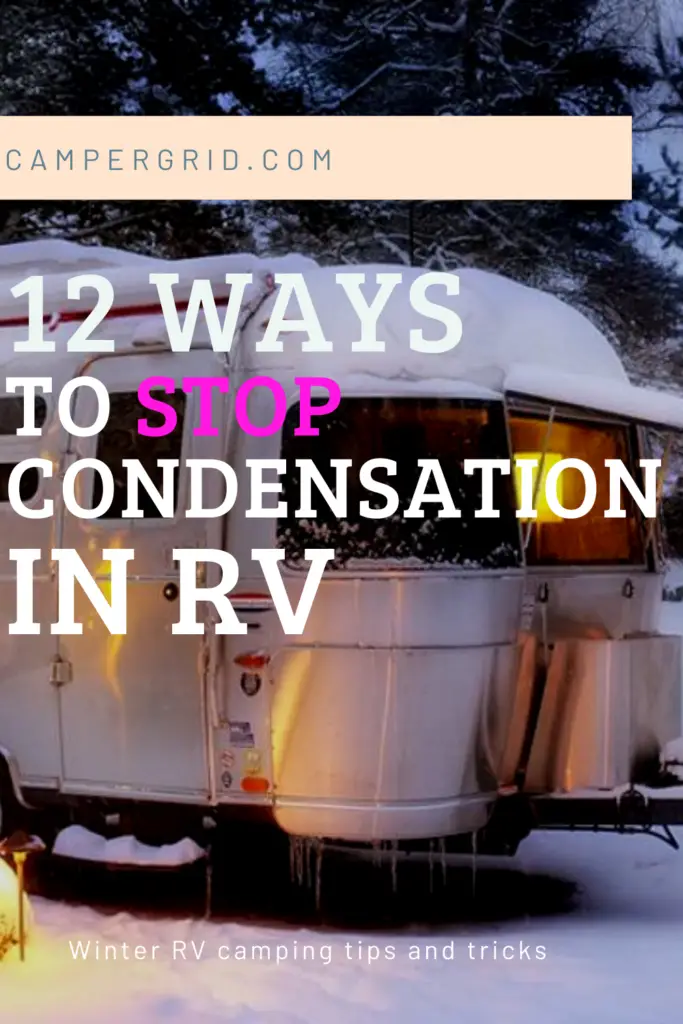
- Use dehumidifier to remove the moisture from air
- Use moisture removing products like damp rid or Eva-dry
- Keep RV warm
- Keep windows slightly open.
- Insulate the RV
- Use double pane windows
- Use lids while cooking
- Avoid long hot showers
- Avoid wet clothes inside the RV
Now, lets discuss each of these tips in detail. The first one is an important one.
Using dehumidifier is a better and tested way to stop condensation. Most full time RVers use this method.
Its a method that will cost a little higher but it is also an effective way out. Most full time RVers will agree to this. Its an investment for good.
Read on to understand each methods.
1. Make use of dehumidifier
This is probably an easier one if you don’t want to follow other tips. Get an electric dehumidifier and run it whenever you feel there is moisture. These are small devices that work great and help in getting the moisture away easily.
The only thing you need to keep in mind is that they need good amount of power so be ready with your batteries or other sources when not connected to electrical shore power.


How long you should run it? It totally depends on what’s the moisture situation is like.
Ideally, you should keep the relative humidity at controlled level. To do that, you may have to turn it off and on. You can use hygrometer to see the humidity level.
Below is the table that shows recommended relative humidity levels for different outside temperatures.
| Outside Temperature | Relative Humidity |
|---|---|
| +40 F | 45% |
| +30 F | 40% |
| +20 F | 35% |
| +10 F | 30% |
| 0 | 25% |
| -10 F | 20% |
| -20 F | 15% |
You don’t want the dehumidifier to make RV air very dry as this can create health problems for you.
Getting the right Dehumidifier
Humidifier is a great way to control condensation. But, before you buy this make sure you are buying the right one. Getting right size humidifier is critical as otherwise it will defeat the whole purpose and you would still be at same position trying all other things.
Ideally, with a dehumidifier you should be able to avoid condensation provided its of proper size.
Below are some of the points to verify before you buy a humidifier.
Check on power consumption
They can be power eater so make sure you get one that is energy efficient. Check for reviews online to check which one is a power saver.
Size
RV’s mean you have to manage with whatever space you get. Simply packing things inside may not be good as it will eat up space and put extra weight as well. Get a dehumidifier that is compact and isn’t too heavy.
Hygrometer
Some dehumidifiers come with built in hygrometers that can tell the relative humidity. Tracking humidity inside your RV or motorhome can be helpful. A 30%-50% humidity inside the RV is considered to be good. So if you know what’s happening with humidity you can take steps to control it and avoid condensation.
Check the noise level
Dehumidifier can be noisy at times even though newer ones tend to be quite. Make sure you buy a one that isn’t noisy.
Check capacity
Dehumidifier capture water and for that they have certain capacity that is calculated in terms of pints. They can come in 25, 50 or 75 pints normally. Make sure you have sufficient capacity in the humidifier. A smaller one will mean you will have to empty in again and again.
2. Use Moisture absorbing products
If you live and RV in warmer environment then using a moisture absorbing product can be great. Instead of trying various other things you should get that crystal like product that can absorb the extra moisture inside the RV. Damp rid is one such product that a lot of people talk about.
Make use of such a product and you should be just fine initially. If you fee it isn’t helping much then go for other recommendation. Its important to curb the mold and mildew causing condensation as otherwise you could be facing more consequences.
Such products work without any power and you can say they are similar to dehumidifiers without power source.
3. Convert to double pane window or insulate the single pane windows
Most of the times RV’s don’t come with double pane windows and it is for reasons. But, a single pane window that isn’t great in insulation can result in creating moisture and thus condensation.
So, what to do? You can convert to double pane window if the condensation is a big deal for you because of the weather you are in. A single pane windows becomes colder and it facilitates for condensation easily.
This idea of switching to double pane windows however may not be ideal. You need to think a lot before going for this. Instead of going for double pane window you can simply try to add more insulation to your window. This way you don’t have to face consequences of double pane window and you will also avoid condensation.
4. Use heater to increase the temperature
Increasing the temperature inside the RV or pop up camper can be a great way to keep condensation away. Use a space heater for this or even baking a cake inside your small oven can do wonders.
Even though getting the temperatures increased can keep the condensation lesser it may not work if the outside temperature falls very low.
5. Maintain proper air circulation
One of the ways to keep condensation low is by having proper air flow inside your camper. Crack open the window or keep it opened fully when the temperature isn’t too low. This will allow the vapor to not settle down on walls or any other things inside the RV.
A lot of times you are able to get rid of or wipe out the condensation happening on windows or walls but what about hidden regions?
A cabinet or closet wall can also get condensation and that can be hard to figure out. Having good air flow will make sure this does not happen.
Did you know that roof vents can be great in keeping good air circulation in RV?
6. Avoid drying clothes inside the camper
Drying clothes inside your camper can be very bad thing to do specially in winter. All the water from drying clothes will cause vapors and will lead to condensation and dampness. Don’t ever try this for saving money, you will end up spending even more and an annoyance separately.
A lot of people unknowingly do this and that ultimately results in windows and other walls getting condensation. Drying clothes at night especially can be a major cause of condensation, so be sure you don’t do this at all.
7. Cover up hot pans and pots
Cooking in a hot pan and pots will result in vapors which can be causing condensation if you do it regularly. Be sure to cover such pots so that the vapors get blocked on the covering.
This is a very small thing to do but if you neglect it over a period of time then be ready to face the condensation and resulting molds and dampness.
Cooking itself during winter times can result in condensation as you cannot completely block the vapors going in air. So, one can avoid cooking inside if possible.
8. Keep cabinets or closets slightly opened
Condensation not only is seen on window glasses but also inside a closet or cabinet walls. Keeping them tightly closed can increase the chances of condensation if the temperature is favorable for that.
Making sure the closets/cabinet are slightly opened will allow for better air circulation inside. Specially, when people are full time Rving this is more critical as the closets would remain fully packed and that can result in more issue like clothes getting musty smells, dampness etc.
9. Use campground shower if possible
Using showers inside the tiny RV can create vapors that will obvious result in condensation. During winter when you take that hot shower will mean a lot of vapors which will sick to walls and ceiling if not allowed to escape.
If you are full time living in RV then that can be a really bigger impact as you will be using the shower multiple times. When you know the humidity is high make sure you limit the shower use.
Try to use campground showers if possible. A lot of campgrounds come with shower facility and you shouldn’t have difficult with them.
10. Wipe out vapors and moisture as you see it
When you have so many water based things to do inside the RV, there will be moisture and vapors for sure. But, if you take things seriously and clean the moisture as soon as you see it, it can make things easy. This is for sure a great way to reduce condensation in a camper trailer.
11. Use exhaust fan
Using exhaust fan while you are in shower or when you are cooking can help keep the vapors in air rather than sticking on walls. What the exhaust fan will do is, it will keep the air moving and throwing out cold air.
This can work great if you cannot avoid certain things. Cooking hot dishes can create vapors which can be difficult to take away and exhaust fan does a great job in keeping them away.
12. Make sure camper is clean and dry
Keeping the camper clean and tidy should always be your priority. Keeping it unclean and not dry will obviously lead to condensation. Its not only the drying of clothes that will result in condensation but any wetness inside will lead to dampness.
Be sure to make the camper as dry as possible. Keeping any water on floor or anywhere near the kitchen can led to vapors as the water dries.
Why condensation or moisture is bad
Condensation can facilitate the growth of mold and that can eb the vary reason why you want to get rid of it. Mold, once starts growing can be very bad for your RV. If neglected it can be difficult to remove without using proper treatment.
Thus, preventing the condensation is a proper way to stop mold inside your RV. As humidity increases, the moisture would grow and thus controlling the humidity is a way to stop everything. Optimal humidity should be between 30 to 50%.
Full time RVing
Four seasons RV is the right type of RV that will have good insulation and design that will keep the condensation to minimum levels. If you want to live full time then be sure to get such an RV else you may end up trying different things to stop the condensation.
Conclusion
Whether you have pop up camper or travel trailer or a bigger motorhome, condensation can happen inside it. Measuring humidity levels and taking steps to prevent the condensation can be done using many steps. But, a lot depends on where you live and what kind of RV you have. Keeping a small humidity measuring device can help you figure what to do.
Keeping the RV dry and clean is another great preventive method that we discussed. Taking bigger steps like changing to double pane windows should be taken after much thought. Dehumidifier is again a great device to fight condensation and mold.

